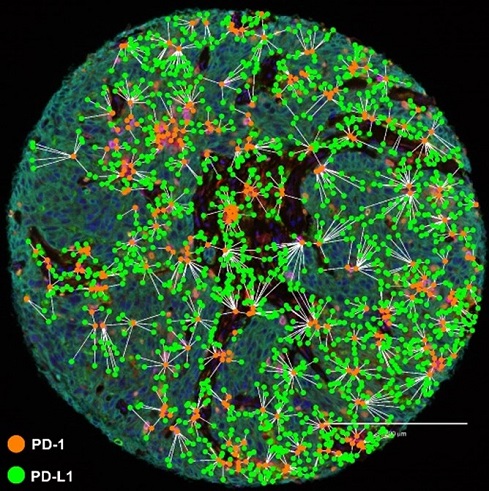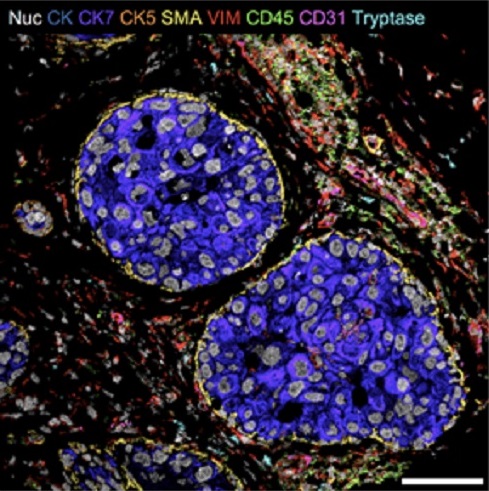Footnotes
- Beth Israel Deaconess Medical Center, News section (August 18, 2021)
- St. Jude Research, Translational Innovation section, Spatial omics (2022)
- Genomeweb, Tools & Technology, Sequencing (Oct 05, 2020)
KPMG perspective on this innovative technology

The precision medicine market is continuously adding new tools to expand capabilities across translational research, clinical applications, as well as therapeutic development and innovation. With spatial omics imaging expanding upon single cell profiling, we believe that adoption of this technology could accelerate from academic laboratories and into the broader life sciences ecosystem - if it continues to prove its worth, and systems become more automated and cheaper
Figure 1: Size and growth of the global spatial omics market by application and end user
Global Spatial Omics Market by Application ($M)
Global Spatial Omics Market by End User ($M)
Figure 2: Image of a breast cancer sample where the spatial proximity of the biomarkers PD-1 and PD-L1 is being analyzed

Source: Lu S, Stein JE, Rimm DL, et al. Comparison of Biomarker Modalities for Predicting Response to PD-1/PD-L1 Checkpoint Blockade: A Systematic Review and Meta-analysis. JAMA Oncol. 2019
Figure 3: Ductal carcinoma in situ (DCIS) cells shown with 9 different markers simultaneously, used for profiling tissue architecture within heterogenous microenvironments

Sources: Risom T, Glass D, Liu C, et al. Transition to invasive breast cancer is associated with progressive changes in the structure and composition of tumor stroma. Cell. 2021
Adoption of spatial omics imaging has its challenges. For one thing, the technology doesn’t come cheap. Investment costs in spatial omic platforms and workflows range anywhere between ~$300k-~$1M and requires highly trained technicians to operate. Academic medical research institutions may seem unlikely end users, but access to large tissue repositories means researchers at these institutions can more easily secure funding from government organizations and other sources to purchase equipment. This ultimately results in published research on new applications of spatial omics imaging in areas such as immuno-oncology and neurology, which in return promotes the capabilities of this nascent technology.
Reflective of this academic interest, in August 2021, Beth Israel Deaconess Medical Center (BIDMC), in association with Harvard Medical School, received a $3.3M grant from the Massachusetts Life Sciences Center (MLSC) to open the BIDMC Spatial Technologies Unit, one of the first of its kind worldwide(1). Furthermore, as part of its 2022-2027 strategic plan, St. Jude’s will construct its Center for Sp
We believe spatial omics imaging has the potential to be a powerful tool outside of the academic setting. Currently, the study of tissue microenvironments is being performed using historical samples from repositories. However, as the technology is further validated, it’s likely that spatial omics imaging will transition from research-use-only applications and transition to precision medicine settings at healthcare providers. Even though this is likely a ~10-15 year outlook in terms of feasibility, some cancers that are easily accessible for biopsy could see real time diagnosis using spatial omics technology sooner.
For biopharma, there are a vast array of potential uses for spatial omics imaging. From measuring viral vector target specificity as part of the development of cell and gene therapies, to assessing the tissue penetration of targeted cancer agents, spatial omics imaging could prove to be a major game changer for the industry as precision medicine becomes an increasingly important part of biopharma portfolios. The technology also has potential utility beyond oncology, in areas such as Alzheimer’s and immunological disorders, where drug developers need to assess how new therapies drive or inhibit immune responses.
To support the biopharma ecosystem, clinical research organizations like BioChain and LabCorp Drug Development, which provide biorepository and translational research services, are beginning to utilize spatial omics technologies and offer services to assist in drug development.
To help accelerate adoption, life science players that develop and manufacture these instruments are designing automated systems for less hands-on operation. Spatial omics imaging companies like Nanostring and Akoya Biosciences have developed fully automated solutions offering rapid, whole-slide imaging platforms that are designed for easier end-to-end operation, with others such as Rebus Biosystems and Lunaphore developing closed system solutions that respectively offer transcriptomic and proteomic profiling with high throughput imaging.
In addition, companies like 10X Genomics, which jumped into the spatial race with the acquisitions of Readcoor (for $350M) and Cartana (for $41M) in October 2020, now offer innovative new products like the Visium Gene Expression slide for labs that already have spatial capable high-definition microscopy platforms, without the need to invest in completely new workflows(3).
As more of these automated products enter the market and increasing interest is shown from the medical and biopharma industries, it is hoped that this demand drives down pricing to enable broader penetration into the healthcare and life sciences ecosystem.
The advent of genomic sequencing and transcriptomics was key to unlocking the blueprint of diseases at the single cell level. However, spatial omics imaging offers a bridge between individual cells and their surrounding environments that could allow physicians and therapy developers a powerful new tool in better understanding diseases within microenvironments, with the possibility of more accurate and effective treatments to follow.
1
2
3
In the complex and fast-moving Precision Medicines market clients seek advisors who can provide deep scientific, technical and business insights at a local and global level. Our Precision Medicine practice is part of KPMG Healthcare and Life Sciences (HCLS) Deal Advisory and Strategy (DAS), which supports the development and execution of organic and inorganic strategies across the HCLS continuum. Our Precision Medicine practice is a leader in this innovative area of medicine across all therapeutic areas, in markets around the world, with all relevant stakeholders and fueled by experience across the value chain. Visit the Precision Medicine site to see more examples of the transformative work we are doing in strategy, deals and operations for all stakeholders in the Precision Medicine ecosystem.


